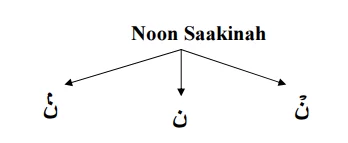Have you ever heard the term “Noon Saakin” or “Tanween” in the Arabic language? Do you find it challenging to pronounce words that contain a Noon Saakin properly? If you are learning the Arabic language, you may have encountered the Noon Saakin rules, and you may find it difficult to grasp its concept. In this article, we will discuss everything you need to know about the Noon Saakin rules, including its definition, types, and pronunciation.
Noon Saakin
Noon Saakin is a term used in the Arabic language to refer to the letter Noon (ن) when it is pronounced with a Sukoon or a Tanween. The word “Saakin” means “to dwell” or “to be at rest,” which means that when the letter Noon is pronounced with a Sukoon or a Tanween, it is pronounced as a complete stop without any vowel sound.
Understanding the Noon Saakin rules
The Noon Saakin rules state that when a Noon letter has a sukoon, it must be pronounced by stopping the airflow completely for a short duration. This means that the tongue should touch the roof of the mouth at the point of articulation for the Noon letter and then release the air after a short pause. This pause should be equal to the length of one vowel.
For example, let’s take the Arabic word for “house,” which is “bayt.” The Noon letter in this word has a sukoon, so we must apply the Noon Saakin rule. To pronounce this word correctly, we need to stop the airflow completely when we reach the Noon letter, touch the roof of our mouth with our tongue, and then release the air after a short pause, which should be equal to the length of one vowel.
Types of Noon Saakin

There are three types of Noon Saakin:
Tanween
Tanween is a symbol written on top of a letter to indicate that it should be pronounced with a short “n” sound. Tanween is represented by two small dots called Nunation or Tanween. There are three types of Tanween:
Fat-hatan (ً) – pronounced as an “an” sound
Kasratan (ٍ) – pronounced as an “in” sound
Dhammatan (ٌ) – pronounced as an “un” sound
Sukoon
Sukoon is a symbol written above a letter that indicates that the letter should be pronounced with a complete stop without any vowel sound.
Shaddah
Shaddah is a symbol written above a letter to indicate that it should be pronounced twice. Shaddah occurs when the same letter appears twice in a row.
Importance of Noon Saakin

Noon Saakin plays a crucial role in the Arabic language. It changes the meaning of words and helps in proper communication. Mispronouncing Noon Saakin can lead to misunderstandings and miscommunication. Hence, it is essential to understand the Noon Saakin rules and the proper pronunciation of words.
The Proper Pronunciation of Noon Saakin
Proper pronunciation of Noon Saakin can be challenging for beginners, but with practice, it can be mastered.
The letter Noon with a Tanween is pronounced by:
Placing the tongue at the roof of the mouth
Saying “n” sound for the duration of one short vowel
Exhaling at the end of the vowel sound
The letter Noon with Sukoon is pronounced by:
- Saying the letter “n” sound without any vowel sound
- Stopping the air from coming out of the mouth
- Holding the sound for the duration of the Sukoon symbol
- The letter with Shaddah is pronounced
- The letter with Shaddah is pronounced by doubling the sound of the letter. For example, if there is a Shaddah above the letter Noon, it should be pronounced as “nn.”
Learn more about Arabic Vocab for Beginners
Rules of Noon Saakin
Now that we understand the different types of Noon Saakin let us dive into the rules of Noon Saakin.
Idaafa Rule
The Idaafa rule applies when a noun is followed by another noun or a pronoun. In this case, the last letter of the first noun is pronounced with Sukoon. For example, the word “book” in Arabic is “kitab,” and the word “my book” is “kitabi” (with a Sukoon on the letter Ba).
Waqf or Stop Rule
The Waqf rule applies when stopping at the end of a verse in the Quran or during recitation. In this case, the last letter of the word is pronounced with Sukoon.
Taa Marbouta Rule
The Taa Marbouta rule applies when the letter Taa Marbouta (ة) is at the end of a word with a Sukoon on the letter Noon. In this case, the letter Taa Marbouta is not pronounced.
Laam Alif Rule
The Laam Alif rule applies when a word begins with Laam Alif (لا), and the letter Noon Saakin follows. In this case, the Laam Alif is not pronounced, and the letter Noon is pronounced with Sukoon.
Noon Alif Rule
The Noon Alif rule applies when the letter Noon Saakin is followed by the letter Alif (ا). In this case, the Noon is pronounced as a Sukoon, and the Alif is pronounced with a Madd (long vowel).
Exceptions to Noon Saakin Rules
There are a few exceptions to the Noon Saakin rules that beginners must be aware of:
Hamzatul Wasl
Hamzatul Wasl is a glottal stop that occurs at the beginning of a sentence or a word. In this case, the Noon Saakin is pronounced with a Fat-ha, not a Sukoon.
Alif before a word starting with a Hamza
When the letter Alif is followed by a word starting with a Hamza, the Noon Saakin is pronounced with a Fat-ha instead of a Sukoon.
Common Mistakes in Pronouncing Noon Saakin

Some common mistakes that beginners make when pronouncing Noon Saakin are:
- Pronouncing the letter Noon Saakin with a vowel sound
- Not stopping the sound while pronouncing the letter with Sukoon
- Pronouncing the letter twice while pronouncing the Shaddah symbol
Practice Exercises
Practice is crucial to mastering the Noon Saakin rules. Here are a few practice exercises that can help beginners:
- Practice reciting Quranic verses and paying attention to the Noon Saakin rules.
- Practice pronouncing words with Noon Saakin in front of a mirror to check your mouth and tongue position.
- Record yourself while practising the pronunciation of words and compare it with an Arabic native speaker’s pronunciation.
Common mistakes when pronouncing words with Noon Saakin
One of the most common mistakes that Arabic learners make when pronouncing words with Noon Saakin is not applying the Noon Saakin rules correctly. Learners may forget to stop the airflow completely when reaching the Noon letter, or they may pause for too long or too short a duration.
Another common mistake is to confuse the pronunciation of Noon Saakin with the pronunciation of the letter Meem (م) or Yaa (ي) when they have a sukoon. These letters have different points of articulation and pronunciation, and learners should practice distinguishing them to avoid confusion.
Learn more about: learning Quran online advantages
Tips to improve your Noon Saakin pronunciation in Arabian tongue
To improve your pronunciation of Noon Saakin, you should practice saying words that contain Noon Saakin regularly. Listen to native speakers and try to imitate their pronunciation. Pay attention to the length of the pause after the Noon letter and try to match it with the length of one vowel.
It can also be helpful to use visual aids such as a chart that shows the different Arabic letters and their points of articulation. This can help you understand where to place your tongue and how to shape your mouth to pronounce the Noon letter correctly.
FAQs
[sc_fs_multi_faq headline-0=”h2″ question-0=”What is Noon Saakin in the Arabic language?” answer-0=”Noon Saakin is a term used in the Arabic language to refer to the letter Noon (ن) when it is pronounced with a Sukoon or a Tanween.” image-0=”” count=”1″ html=”true” css_class=””]
In conclusion
the Noon Saakin rules are an essential aspect of Arabic pronunciation that every Arabic learner should understand. By applying these rules correctly and practising regularly, you can improve your pronunciation and become more confident in speaking Arabic.
Noon Saakin’s rules can be challenging to understand, but with practice, they can be mastered. Proper pronunciation of Noon Saakin is crucial for effective communication in the Arabic language. Beginners must pay attention to the different types of Noon Saakin, the rules, and the exceptions to avoid common mistakes.


